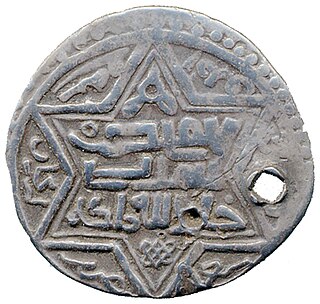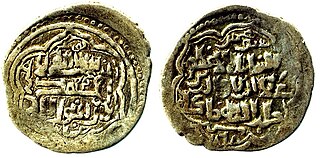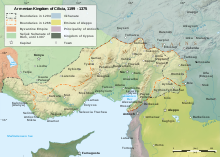
The Beylik of Dulkadir was one of the Anatolian beyliks established by the Turkoman clans Bayat, Afshar, and Begdili after the decline of Seljuk Sultanate of Rûm.

The Eretnids were a dynasty that ruled a state spanning central and eastern Anatolia from 1335 to 1381. The dynasty's founder, Eretna, was an Ilkhanid officer of Uyghur origin, under Timurtash, who was appointed as the governor of Anatolia. Some time after the latter's downfall, Eretna became the governor under the suzerainty of the Jalayirid ruler Hasan Buzurg. After an unexpected victory at the Battle of Karanbük, against Mongol warlords competing to restore the Ilkhanate, Eretna claimed independence declaring himself the sultan of his domains. His reign was largely prosperous earning him the nickname Köse Peyghamber.

Kadi Ahmad Burhan al-Din was vizier to the Eretnid rulers of Anatolia. In 1381, he took over Eretnid lands and claimed the title of sultan for himself. He is most often referred to by the title Qadi, a name for Islamic judges, which was his first occupation.

Shahsuwaroghlu Ali Beg was the ruler of Dulkadir from 13 June 1515 until his death. Ali was the son of Shah Suwar, one of the previous Begs of Dulkadir. Following his father's execution by the Mamluk Sultanate, Ali fled to the Ottoman Empire, where he served in several positions, administering parts of the country and leading the Ottoman army during their fight against Safavid Iran, specifically the Battle of Chaldiran. When Ali's uncle and the ruler of Dulkadir, Ala al-Dawla Bozkurt, was involved in a conflict with the Ottoman state, the latter chose Ali as their puppet to replace Bozkurt, who sided with the Mamluk Sultanate. On 13 June 1515, Bozkurt was killed, and Ali rose to the Dulkadirid throne.

The Emirate of Erzincan was an emirate that controlled much of Eastern Anatolia in the fourteenth and early fifteenth centuries.

Ala al-Din Eretna was the first sultan of the Eretnids, reigning from 1343 to 1352 in central and eastern Anatolia. Initially an officer in the service of the Ilkhanate officer Chupan and his son Timurtash, Eretna migrated to Anatolia following Timurtash's appointment as the Ilkhanid governor of the region. He took part in Timurtash's campaigns to subdue the Turkoman chiefs of the western periphery of the peninsula. This was cut short by Timurtash's downfall, after which Eretna went into hiding. Upon the dissolution of the Ilkhanate, he aligned himself with the Jalayirid leader Hasan Buzurg, who eventually left Anatolia for Eretna to govern when he returned east to clash with the rival Chobanids and other Mongol lords. Eretna later sought recognition from Mamluk Egypt to consolidate his power, although he played a delicate game of alternating his allegiance between the Mamluks and the Mongols. In 1343, he declared independence as the sultan of his domains. His reign was largely described to be prosperous, with his efforts to maintain order in his realm such that he became known as Köse Peyghamber.

Ala al-Dawla Bozkurt Beg was the ruler of Dulkadir from late 1480 until his death. Championed by the Ottoman Sultan Mehmed II, Bozkurt ousted his brother Shah Budak and claimed the throne. Early into his reign, Bozkurt assisted Mehmed's successor Bayezid II in pursuing his claimant brother Cem Sultan, who was harbored by the Mamluk Sultanate. In response, Bozkurt besieged Malatya, which prompted the Mamluks to initiate an offensive against him and the Ottomans. During the conflict, Bozkurt steered away from sending his support to the Ottomans, which contributed to their defeat by the Mamluks.
Shah Budak was Beg of Dulkadir from October 1465 to April 1466 and 4 June 1472 to 1480. During the reign of his brother, Malik Arslan, Shah Budak took refuge in Mamluk Egypt. He took advantage of the discord between Malik Arslan and the Mamluks by provoking the Mamluk sultan to commission his brother's assassination. Malik Arslan was killed in October 1465, and Shah Budak rose to the throne afterwards. However, before the Mamluk forces could come to his aid, he was defeated by his other brother, Shah Suwar, who was backed by the Ottoman Sultan Mehmed II. Shah Suwar was engaged in continuous warfare against the Mamluk Sultanate, whereas Shah Budak took sides with the latter. Shah Suwar was caught by the Mamluk forces on 4 June 1472.

Sayf al-Din Malik Arslan was Beg of Dulkadir from 28 August 1454 until his death. Malik Arslan was one of the numerous sons of his predecessor Suleiman Beg. He first competed with his uncle Feyyaz for the throne and was favored by the Mamluk Sultan Sayf al-Din Inal. Later into his reign, Malik Arslan was involved in the succession wars within the Karamanids. He ransacked the region wishing to retake Kayseri but was defeated by the Aq Qoyunlu ruler Uzun Hasan. In September 1465, Malik Arslan ceded Harpoot to Uzun Hasan, who had taken advantage of the worsening relations between Malik Arslan and the Mamluks. Malik Arslan was assassinated on the orders of Khushqadam, incited by Malik Arslan's rival brother Shah Budak, who replaced him.

Ghiyath al-Din Muhammad I was the second Sultan of the Eretnids in central and eastern Anatolia, ruling from 1352 until his death. He was enthroned at a young age and struggled to maintain his authority over the state his father, Eretna, had founded. Although he was initially preferred over his older brother Jafar, Muhammad was deposed by his emirs early into his reign and was replaced by Jafar. After some time in exile, he returned, restored his throne, and killed his brother. Though, throughout his reign, he dealt with rebellions and lost land to local Turkoman lords, the Dulkadirids, and the Ottomans. After putting an end to his former vizier Khoja Ali Shah's revolt and returning to the capital, Kayseri, Muhammad was murdered by his emirs, who crowned his son Ali as the new sultan.
Zayn al-Din Qaraja Beg was a Turkoman chieftain who founded the Dulkadirid principality in southern Anatolia and northern Syria, ruling from 1337 to 1353. Before his ascendance, Qaraja competed with Taraqlu, another local Turkoman warlord, over the administration of the northern frontier of the Mamluks. After gaining recognition from the Mamluk Sultan Al-Nasir Muhammad, he became the head of a client state on their Anatolian extremity. During his rule, Qaraja grew more ambitious and clashed with various Mamluk governors who were against his expanding influence. Qaraja took advantage of the political turmoil within the Mamluks and declared independence in 1348. However, this led to his imprisonment and subsequent execution in 1353.
Shaban Suli Beg, also known as Sevli Beg, was the third ruler of Dulkadir from 1386 to 1398. Suli's father was Zayn al-Din Qaraja, a Turkoman chieftain, who founded the state of Dulkadir in southern Anatolia and northern Syria as a client of the Mamluk Sultanate. Suli succeeded his older brother Ghars al-Din Khalil, who was assassinated on the orders of the Mamluk Sultan Barquq. Suli was involved in a series of clashes with the Mamluks, in which he was initially victorious, forcing Barquq to recognize him as the new ruler. Barquq continued supporting Suli's rivals, and in 1389, Suli joined a rebellion against the state. He was pardoned in January 1391 but this time allied himself with Timur, perpetrating an invasion of Syria. Suli faced a major loss at the hands of the Mamluks in March 1395 and was assassinated in May 1398 on the order of Barquq. The throne was inherited by his son, Sadaqa.
Sadaqa Beg was the fourth ruler of the Turkoman Dulkadirid principality, ruling from 1398 to 1399. He rose to the throne after his father Suli Beg was assassinated and the Mamluks issued him the manshūr, the diploma to rule. However, Sadaqa was quickly deposed and forced out of Elbistan by the Ottoman Sultan Bayezid I, who allowed Sadaqa's rival cousin Mehmed to be the new ruler.
Nasir al-Din Mehmed Beg was the ruler of Dulkadir, a state in southern Anatolia, from 1399 until his death. After his father, Ghars al-Din Khalil, died, Mehmed repudiated the reign of his uncle, Shaban Suli and clashed with him on several occasions, relying on the support of the Mamluk Sultanate that ruled Egypt and Syria. Following Suli's murder, his son, Sadaqa, rose to the throne. Mehmed succeeded in claiming power shortly after with the intervention of the Ottoman Sultan Bayezid I. During the Ottoman Interregnum (1402–13), Mehmed supported Bayezid's son Mehmed Chelebi, who became the new sultan. While Nasir al-Din Mehmed was involved in sporadic skirmishes with the Mamluks, he enjoyed peace with them towards the end of his reign, marrying his daughter to the Mamluk Sultan Jaqmaq and commissioning the construction of madrasas and other buildings in Mamluk-controlled regions, such as Jerusalem.
Suleiman Beg was the ruler of Dulkadir, a principality in southern Anatolia, from 1442 until his death. During the reign of his father, Nasir al-Din Mehmed, he served as the wali (governor) of Kayseri. His reign was relatively uneventful. His major accomplishment was the arrangement of the political marriages of his daughters to the rulers of two major powers that the Dulkadirids formed a buffer region between, the Ottoman Sultan Mehmed II and the Mamluk Sultan Sayf al-Din Jaqmaq. Towards the end of his reign, Suleiman was involved in the internal struggle of the Aq Qoyunlu, members of whom sought safety under him. Following the end of this conflict, Suleiman led an unsuccessful siege on Çemişgezek. He had numerous offspring, among whom four sons would consecutively rule the state. He was succeeded by Malik Arslan.

Shah Suwar was the ruler of Dulkadir from April 1466 to 4 June 1472. Upon the assassination of his brother, Malik Arslan, he competed for the throne against his other brother Shah Budak, who took over with the support of the Mamluk Sultanate. Shah Suwar was welcomed by the Ottoman Sultan Mehmed II, who appointed him to a number of positions in his realm. Six months into Shah Budak's reign, Shah Suwar defeated him and instead became the new ruler in April 1466. The Mamluks fiercely disputed Shah Suwar's reign. The Sultans Khushqadam and Qaitbay launched multiple consecutive campaigns to subdue him. Shah Suwar initially triumphed over the Mamluks and expanded his territory, occupying the entirety of the Ramadanid realm.
Sarim al-Din Ibrahim I was Beg of Ramadan by June 1354 to 1383. Following his father Ramadan's death, Ibrahim arrived in Damascus and honored the Mamluk Sultan, securing the regional authority the Mamluks had granted Ramadan. Soon after, Ibrahim allied himself with Ghars al-Din Khalil, the ruler of the Dulkadirids, in an attempt to seize Sis. The Mamluk governor of Aleppo was assigned to deal with Ibrahim but was defeated by other local lords. The Mamluks recognized Ibrahim's authority in 1381 and granted him the title na'ib (viceroy) of Adana two years later. Ibrahim made a new attempt to realize his ambition to capture Sis. This restored the state of war between the Ramadanids and the Mamluk Sultanate. After fleeing from the Mamluks for some time, Ibrahim was caught by the Mamluk na'ib of Sis. Ibrahim was executed in the town of Sis. He was succeeded by his brother Ahmed.

Ala al-Din Ali was the third Sultan of the Eretnids ruling from 1366 until his death. He inherited the throne at a very early age and was removed from administrative matters. He was characterized as particularly keen on personal pleasures, which later discredited his authority. During his rule, emirs under the Eretnids enjoyed considerable autonomy, and the state continued to shrink as neighboring powers captured several towns. The capital, Kayseri, temporarily came under Karamanid control. Kadi Burhan al-Din rose to power as the new vizier and dispatched Ali to lead several campaigns, most of which were unsuccessful. Ali died of the plague in Kazova in an expedition to subdue Shadgeldi, the emir of Amasya.
Ala al-Din Ali Beg was a Dulkadirid prince who served the Mamluk Sultanate of Egypt and Syria. During the reign of his father, Khalil, Ali received land around Aleppo from the Mamluk Sultan Barquq, although it is unknown whether this was just an honorary rank or if some service was required. The Mamluk Sultanate an-Nasir Faraj appointed Ali as the governor of Aintab in July 1402, which he later lost on an unknown date. The new sultan al-Mu'ayyad Shaykh instead transferred the city's rule to Ali's brother Nasir al-Din Mehmed in November 1411, the leader of the Dulkadirids as an appreciation of Mehmed's support for his rise to power. However, in the spring of 1417, al-Mu'ayyad Shaykh led two expeditions against the Dulkadirids, the first of which retook Aintab and Darende, and Ala al-Din Ali joined the latter campaign. The Mamluks then trusted Ali and Ali's son Hamza with the administration of Elbistan and Marash, respectively. This lasted a short period as Mehmed restored Dulkadirid rule in Elbistan. Afterwards, Mehmed sought more amicable relations with his relatives and the Mamluks, appointing Ali as the governor of Marash. Through the orders of the Mamluk Sultan Barsbay, Mehmed regained Aintab and Darende, which Ali had been reassigned as the governor of by the previous Mamluk ruler Sayf al-Din Tatar. Although Ali kept Marash, he was executed by Barsbay in June 1426. His son Hamza briefly controlled Marash but was succeeded by Mehmed's son Fayyaz.
Bozdoğan, or Buztughan, is a Turkoman tribe.











